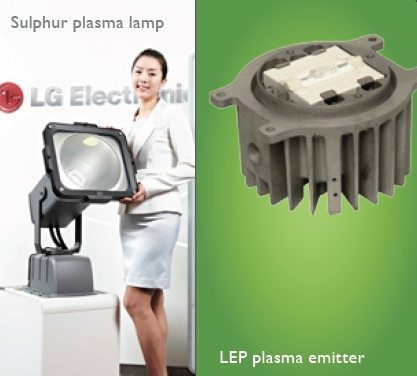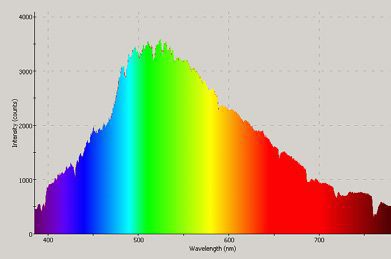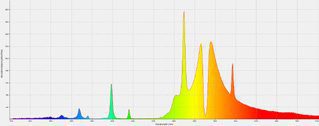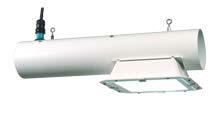There are many new exciting developments in climate room lighting. As scientists start to understand more about the influence of light quality in respect to quality and yield of the crop, two technologies are emerging: LED and Light Emitting Plasma (LEP).
LED stands for Light Emitting Diode. It’s a technology based on semiconductors as you find in transistors and chips. One of the characteristics of a LED is that it emits light at a very narrow bandwidth, resulting in a single pure color that only covers a small portion of the light spectrum. Though the intensity of current high power LED systems is very high, you will always need an array of LEDs as grow light solutions.

Light Emitting Plasma (LEP) are a new type of plasma grow lights. Sulphur Plasma lighting has already been commercially available for a long time, but these units are bulky, noisy, have moving parts in them and are always high output (>700W). It is very difficult to spread the high amounts of light from such a small source over a large area. You need to keep a lot of distance between the lamp and the crop to make Sulphur Plasma work. In many climate rooms you don’t have that distance.
LEP is a technology that enables the production of compact, small plasma lights without any moving parts. It makes the technology suitable for climate rooms. The principle is very simple: Using concentrated radio frequency radiation a gas and metal halide mixture is heated in a vial until it forms into plasma which emits a very intense full spectrum light. Other than the technology used to generate the light, the biggest difference between LED and LEP is the spectral quality: LEP technology enables a very high quality, full continuous spectrum and includes UV radiation. Though there are white (full spectrum) LEDs available most are based on a phosphorous light emitting layer (like a CFL) and do not generate a full continuous spectrum. To achieve
that it is necessary to mix several colors of LED into an array, and include UV LEDs, which are very expensive.
So LEP seems to have really good cards for climate room lighting and it is an emerging new technology. To understand the impact of quality lighting in a commercial climate room we need to understand first how important it is to give the crop high quality lighting, and specifically: what is high quality lighting?
LIGHT QUALITY

Solar light spectrum
Many studies have shown that full continuous spectrum with sunlight quality is the best spectrum for healthy plant development. This is a full continuous spectrum which includes UVA and UVB, far-red and infrared. It also includes a lot of green light and here is something we need to clarify.
If you study the solar spectrum you will see that green light accounts for the highest amount in the spectrum. It would be a waste of Mother Nature not to use that. Our eyes for example are most sensitive to that green color because we have evolved such sensitivity to see in the daytime. Most plant response curves however such as the famous Keith McCree curve (fig 2) show a lower relative photosynthetic efficiency for blue and yellow/green light. This is correct for low PAR levels. Recent studies however have shown that the green light, which is most abundant in sunlight, is very efficient when used in high intensity lighting. In fact, at high irradiation levels the green light is equally or more efficient than other colors.

Efficiency of light in the PAR spectrum (in low light environments)– McCree ’73 – P curve is plant sensitivity curve, V curve is human eye sensitivity.
There are many important processes which are influenced by the quality of the spectrum. Two very important factors are photosynthetic rate of the leaves and the morphogenesis of the plant (the structure of the plant). Photosynthetic rate describes the level of photosynthesis in a leaf. In sunlight conditions you will see the formation of sun leaves which have a very high photosynthetic rate. This enables the plant to develop really fast and use the light very efficiently. Also the position of the leaves is optimized to intercept the light, which is steered by colors in the spectrum. These two aspects are mostly responsible for the fast vegetative development of plants under simulated sunlight or full spectrum plasma light. To build and maintain the photosynthetic system of a plant you need blue light in every grow phase.
The UVA and UVB in the LEP light harden the plant and thicken the leaf surface which is better protected against (fungal) infections. UVB also increases the flavonoids and volatile oils in the plant which results in a much better plant aroma for example.
Overall high intensity LEP is the best solution for a climate room to simulate sunlight conditions, specifically in the vegetative stage when the plants are small and still need to develop. But is it efficient?
LIGHT EFFICIENCY
High-pressure sodium lamps are known as the most efficient lamps to produce photons for grow light. However, the quality of that light is not so good. Analysis of the HPS spectrum shows a start of the effective spectrum at about 560 nm (yellow to red). Below that wavelength, there are a few small spikes, but not a balanced continuous availability and not enough in the blue spectrum.

Typical High Pressure Sodium spectral distribution diagram.
Research in greenhouses shows that you need at least 7% blue light (in a greenhouse from sunlight) for a healthy crop, as the blue light also maintains the photosynthetic system. It is important to know that in high intensity lighting there is not a lot of difference in efficiency between blue and red light. In climate rooms it is common to use Metal Halide (MH) lamps to add additional blue spectrum. MH lights however do not have a long lifetime, are generally not very color stable, have a spiky spectrum, are not as efficient as HPS and generate a lot of heat. Ceramic Metal Halides (CMH) are already better in stability and efficiency but still do not have the spectral quality of the plasma lamp nor the UV radiation. So how efficient is Plasma light compared to HPS? Is it an alternative?
The plasma process of generating light is by itself very efficient: The conversion from energy into actual light is very efficient and generates a very low percentage of heat radiation in the light; the light itself is very “cool”. In the process of getting the energy to the small plasma cell you still lose a lot of energy, which is dissipated into convection heat from the fixture’s driver, power supply and emitter. That heat will never reach the plant though as it rises up and is extracted. For temperature controlled climate rooms there are air cooled LEP fixtures available as well.

Air cooled plasma light
LEP is more efficient than high temperature MH lamps and much more stable. The lifetime is as much as 30,000-50,000 hours compared to the 2,000 to 4,000 of a MH. It has a better light quality and is more efficient than MH, but is it more efficient than HPS? No, it is not. Actually HPS is 1,5-2 times more efficient in generating photons than plasma light. But the HPS light quality is really bad. That sounds like a catch 22. Either you have good light and bad efficiency or good efficiency and bad light!
FOR A SOLUTION WE GO BACK TO THE GREENHOUSES
If you understand that you need a minimal amount of additional quality spectrum to guarantee a healthy crop (just like in the greenhouses) you would like to bring in some additional spectrum, at least to complement the blue light up to 7%. Also you want to introduce all the colors that HPS is lacking, basically all under 560 nm. A 300W LEP can provide just that in combination with up to 1,200 W HPS light. This does not re-create the full solar spectrum and still has more red light in it, but it is sufficient for a healthy crop.
It all makes sense. In greenhouses you need a percentage of quality sunlight to guarantee a healthy crop when using HPS lighting, in climate rooms you create that sunlight by adding LEP to an appropriate level. LEP extras are the UVA and UVB in the spectrum you normally don’t get in a greenhouse because of the glass roof which shields UV in most cases.
WHICH LEP FOR WHICH PURPOSE?

Gavita Pro 300 LEP 01 fixture
Recently Gavita Holland, a horticultural lighting innovator, introduced a LEP fixture which produces less red spectrum and more green and yellow for use in combination with HPS. The philosophy behind that is very simple: HPS is the most efficient technology to produce red light, so why would you want your LEP to produce this red spectrum when used in combination with HPS? This type 01 emitter is more efficient to use in combination with HPS and still provides enough quality spectrum for a vegetative cycle. The spectrum of the 01 emitter primarily picks of where the HPS stops. Another advantage of the 01 emitter is that is has a 50,000 hours lifetime over 30,000 hours for the 02 emitter.

The spectral difference between the 41.01 and 41.02 LEP emitter.
The original LEP with 02 emitter is also still available from Gavita and other LEP fixture manufacturers, and produces the best spectrum for a pure vegetative cycle or for artificial sunlight, for example for a dedicated vegetative climate room. It is still a good choice to use it with HPS, though the 01 green emitter has the advantage there. There is something to choose now when it comes to plasma lighting.
Great article!